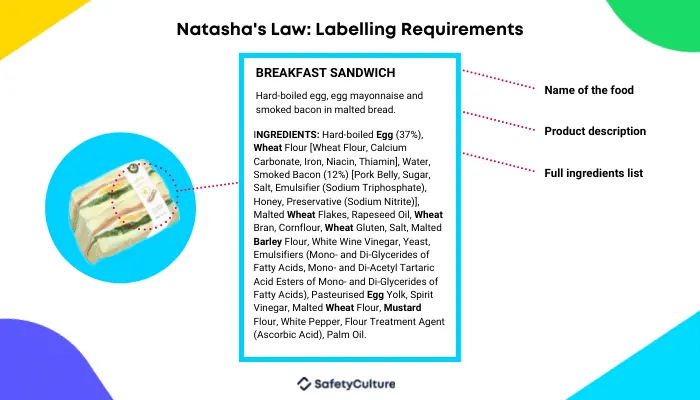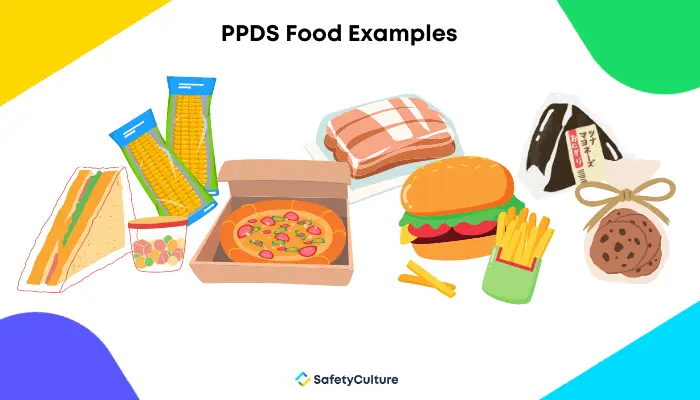What is Natasha’s Law?
The UK Food Information Amendment, also known as “Natasha’s Law” intends to protect food allergy sufferers and give them security in the food that they are buying. Natasha’s Law aims to increase transparency within the food industry in order to better protect both the customers and businesses.
Natasha’s Law took effect on the 1st of October 2021—requiring all food produced and packed for sale in the same premises to provide complete ingredient lists. This means that any food business selling Prepacked for Direct Sale (PPDS) foods will be required to identify all ingredients on the product label, with an emphasis on the 14 allergenic ingredients.
Any food that is wrapped in foil, in a membrane, or in paper bags before being sold is targeted by this law. This new legislation covers England, Wales, Scotland, and Northern Ireland.
Food Allergies
Food allergy and food intolerance—also known as food hyper-sensitivity—are major conditions that affect millions in the population. Around 1 in 4 people in the UK—or 3.5% of the population—live with a diagnosed food allergy and about 600,000 are living with Celiac Disease (a condition that requires a Gluten-free diet). According to the Asthma and Allergy Foundation of America (AAFA), around 26 million (10.8%) of adults and around 5.6 million (7.6%) of children in the United States have food allergies.
We are yet to find a cure for allergies but they can be managed by trigger prevention and treatment. It is one of the most prevalent, but often neglected, diseases around the globe.
There are foods that cause life-threatening effects when eaten like the 14 most dangerous allergens identified by the Food Standards Agency. They are:
- celery;
- cereals containing gluten (found in barley and oats);
- crustaceans (such as shrimps, crabs, and lobsters);
- eggs;
- fish;
- lupin;
- milk;
- molluscs (such as mussels and oysters), mustard;
- peanuts;
- sesame;
- soybeans;
- sulphur dioxide and sulphites (if at a concentration of more than ten parts per million (ppm)); and
- tree nuts (almonds, hazelnuts, walnuts, brazil nuts, cashews, pecans, pistachios, and macadamia nuts).
Food information to Consumers (FIC Regulation) came into effect on December 13, 2014 requiring food businesses to list allergenic ingredients used in prepacked foods. Any meal containing any of the 14 main allergens mentioned previously must be labeled (on a sticker or in other material such as menus)—emphasized by font, style, or background color.
July 2016 Incident
On July 17, 2016, teenager Natasha Ednan-Laperouse lost her life after a cardiac arrest caused by an allergic reaction. It was triggered by a prepacked baguette which, at the time, did not have allergen labelling. Natasha suffered an anaphylactic reaction to the sesame seeds of the baguette.
To improve the quality of life of persons who have food hypersensitivity and to assist them in making safe and informed food choices—allowing them to manage risk effectively—Natasha’s Law was enacted.
Allergen Labelling for Different Types of Food
There are a variety of ways to communicate allergen information to customers for different types of food. We’ll look at two of these types—the prepacked foods and PPDS foods.
Prepacked Foods
Prepacked food is food that has been bottled, canned, cartoned, or securely wrapped before being served or received, whether in a food establishment or a food processing factory. A list of of ingredients must be present on the packaging of prepackaged food. Allergens in the product must be highlighted in the ingredients list.
Prepacked for Direct Sale (PPDS) Foods
It refers to food that is packaged in the same location as it is provided or sold to consumers, and is packaged prior to being ordered or selected. It can include food that people choose for themselves (for example, from a display unit), as well as items stored behind a counter and some meals sold at mobile or temporary locations.
Labelling Requirements

Labeling Requirements | SafetyCulture
Sandwiches, salads, and pies prepared and sold on-site are some examples of common items that fit into this category. Under Natasha’s Law, PPDS food, not only the prepacked foods, will have to clearly display the following information on the packaging:
- Name of the food
- Full ingredients list, with allergenic ingredients emphasized (for example, in bold, italics, or a different color)
Examples of PPDS Foods
Below are examples of PPDS foods provided by Food Standards Agency:
- Sandwiches and baked goods packed on premises before a customer orders them
- Fast food prepared before ordering, such as a burger cooked under a hot lamp
- Prepackaged products such as pizzas, rotisserie chicken, salads, and pasta pots
- Burgers and sausages packed on premises by a butcher for retail sale
- Sample of cookies prepared on site for customers
- Foods packaged by the same business and sold at a market booth or mobile site
- Food served in schools, nursing homes, hospitals, and other comparable institutions

PPDS Food Examples | SafetyCulture
Food Businesses under Natasha’s Law include bakers, butchers, event caterers, fast food and takeaway restaurants, mobile sellers and street food vendors, restaurants, cafés and pubs.
Schools and nurseries are covered as well.
Non-PPDS food
- Food that is not packaged or is packaged after the consumer orders it is considered non-PPDS food. In this case, the name, ingredients, and allergens are not required to be highlighted on the label. Allergen information must still be disclosed, although it can be done verbally.
- Food packed by one company and provided by another is an example of non-PPDS food. Given that this is prepackaged food, it already requires full labelling with allergenic substances highlighted.
Distance Selling
The labelling requirement change does not apply to PPDS food sold via distance selling, such as food purchased over the phone or through the internet. Businesses selling PPDS food in this manner must ensure that mandatory allergen information is available to consumers prior to purchase and during delivery.
Food sellers in distance selling manner provide allergen information in various ways such as:
- Before the completion of the purchase of the food—verbally stated or in writing
- When the food is delivered—in writing (allergen stickers on food or an enclosed copy of a menu) or orally (by phone)
- Between a customer placing the order and taking a delivery of it—allergen information should be available to a customer in written form
- Takeaway meals should be properly labeled to inform customers which foods are allergen-free
Food Business’ Responsibilities Under Natasha’s Law
- Accurate Information – food sellers must provide accurate food labelling information. This information should be updated as new recipes or ingredient lists change or are substituted by suppliers.
- Communication with Suppliers – food sellers need to have good communication with the supplier, who has a legal obligation to provide the exact and full list of ingredients.
- Allergen Awareness Training – ensuring that there is a proper allergen management system and training among staff, and understanding of Natasha’s Law.
Digitize the way you Work
Empower your team with SafetyCulture to perform checks, train staff, report issues, and automate tasks with our digital platform.
Get Started for FreeCompliance to Natasha’s Law
Adherence to Natasha’s Law can help your business grow in providing safe meals to customers who have food allergies or intolerances. SafetyCulture (formerly iAuditor) is a helpful tool in complying with this legislation. See below how SafetyCulture helps food businesses in various ways.



